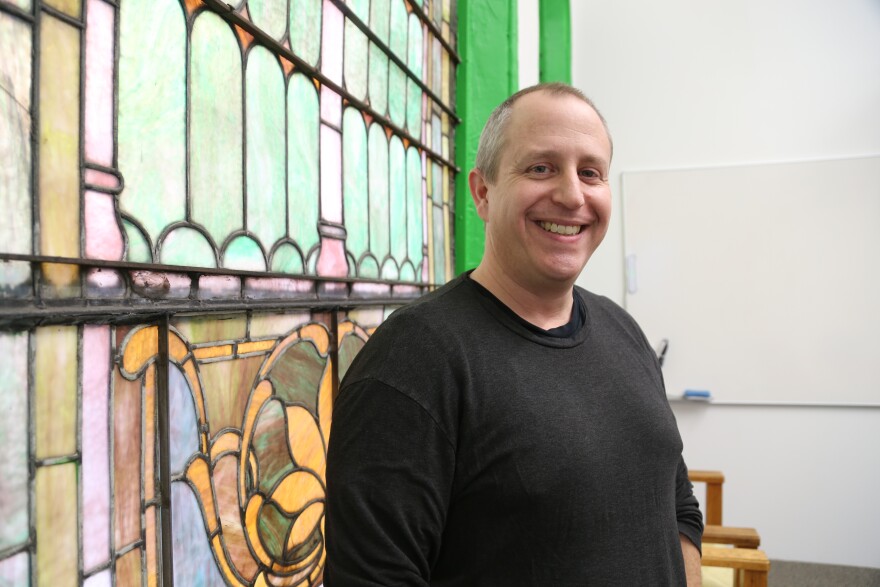Swissvale council member Julie Grose drives to the top of Grand View Golf Course in North Braddock. From up there she can see all of Braddock, the Monongahela River, and on a clear afternoon, east to Oakland and downtown.
“Isn’t this amazing?” she said, taking in the view. But while Grose appreciates the sweep of the rivers and hills, her mind quickly turns to the possibilities.
“We want the history of steel and different industries, but we could have robotics from [Carnegie Mellon University] or Pitt," she said. "Look at all the universities we have here, the intelligence. The innovation we have here, let’s keep it here.”
And by "keep it here," Grose doesn’t mean just Pittsburgh; she means the East Shore.

You may know the East Shore communities as Swissvale, Rankin, Braddock and North Braddock. Since they already have names, tagging them with the East Shore moniker seems like a pretty standard rebranding. Grose resists that narrow interpretation.
“It’s not a rebranding. People are afraid of that, and all the things that happen with that type of change,” she said. “No, it’s more—four neighborhoods, one community.”
Each of the four communities has its own unique identity, said Grose. But there’s been an effort over the last couple years to pool resources, and to share services such as recycling. A shared name makes it easier to do things like that, and to advocate for one another, she said.
A new name can also help the area move beyond the traditional Pittsburgh narrative of being the workshop of the world, said Bill Pfoff, council vice president in Rankin.
“The people we’re trying to attract here aren’t Bill Pfoff’s age, OK?” he laughed. “We’re talking about you know millennials, people that want to come and earn a living, buy a house, live, work, play. And if we stuck to the old thing of, hey, we built steel here, those people don’t know anything about it nor do they probably care about it, you know?”
But moving forward doesn’t mean erasing that past, Pfoff said.
“I think we can respect it, but we can’t tout it to attract new people," he said.
All four communities are represented by the Enterprise Zone Corporation of Braddock, which aims to encourage investment and job creation in the area. The East Shore campaign grew out of that group, explained Evan Indianer, CEO of software company Unicentric.
“We started thinking, wouldn’t it be great if we had a name to put to the collaborative effort of these four communities?”
Indianer is one of those new people Pfoff talks about attracting. Two years ago, Indianer moved his company from the Strip District to the western edge of Braddock. The big brick building he bought stands 100 feet from the gates of U.S. Steel’s Edgar Thomson plant, which has been churning out steel since 1876. Before Indianer moved in, the brick building on Talbot Avenue housed a synagogue and a church. Those layers of history enchanted him.

“There’s a richness, there’s a story,” he said. Now, “it’s being used in a different way but it’s part of the community.”
Sitting within and near all that history could make the East Shore idea seem manufactured by comparison.
“Is it manufactured? Absolutely, but you have to hit the ground running somewhere,” said Indianer. “And only because we started the name are we getting some of the press, are we having the conversations, are people coming to the table.”
And people at that table are likely to disagree. Stentor Danielson is a cultural geographer and associate professor at Slippery Rock University. He said names are much more than just collections of letters.
“They don't just label places. They also create places,” he said. “By grouping these communities together and giving them a single name it's suggesting that all these communities together constitute a single place that has a shared identity.”
Danielson wasn’t familiar with the East Shore campaign. But a new name proposes a new direction, and people may not be able to see their place in that, he said.
“Because whatever direction you go, somebody is going to get left out," he said. "And so who is that going to be.”
The East Shore campaign has been in the works for two years, but it was officially announced at the end of October. People’s Gas provides support, as do a slew of volunteers.
The name is just the beginning, said Swissvale council member Grose; it’s a way to talk about what’s next for these four communities.




